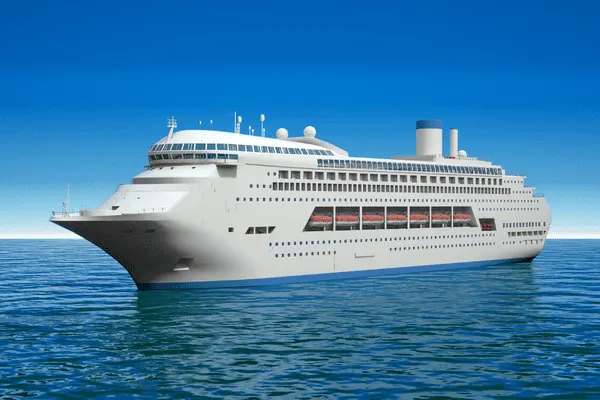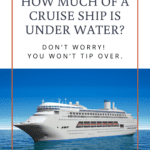When you stand on the shore and watch the massive ships slowly appear over the horizon, it seems improbable that they float and won’t capsize, even in low-sea states. You may wonder how much of a cruise ship is under water that allows it to handle ocean conditions like hurricanes (which they deliberately stay away from) with huge waves.
Let’s take a closer look at how much of a cruise ship is under water and how they are designed for a wide range of conditions.
So, Exactly How Much Of a Cruise Ship Is Under Water?
The amount of cruise ship that is underwater ranges from 20 feet, for a smaller ship, to 31 feet for the largest vessels. It means that only 13% of the ship’s hull and superstructure is underwater, which further reinforces how incredible the technology that marine engineers have developed.
The complete design of a cruise ship is built around the economics of the vessels and the needs, safety, and comfort of the passengers. All of the engineering decisions have been made with these factors in mind, and the results are the impressive cruise ships that travel the seas.

The Depth A Cruise Ship Is Under Water
To calculate how much of a cruise ship is underwater, we want to take the measurement between the cruise ship’s keel (the lowest point of the hull) and the water’s surface; this is called the draught.
The depth of cruise ships’ draught ranges from approximately twenty for smaller ships to more than thirty-one feet for one of the largest cruise ships in the world like Royal Caribbean’s Symphony of the Seas.
The measurement of the draught depends on the following factors:
- The shape of the cruise ship’s hull
- The weight of the cruise ship, including the engines, fuel tanks (whether it is full or not), the hull, superstructure, amenities, cabins, etc
- The weight of the passengers and the luggage
Archimedes was a mathematician, scientist, philosopher, and inventor born in 212 BC and lived in the city of Syracuse in Sicily.
He developed the Archimedes principle, which states that the force needed to keep the cruise ship (or any other floating item) afloat in the water must equal the weight of the water it displaces.
Royal Caribbean’s Oasis-Class generally contains the world’s largest cruise ships, such as Wonder of the Seas and Symphony of the Seas. The Oasis-Class ships have a displacement tonnage of about 100,000 tons. So those ships will displace 100,000 tons of water. (Note that displacement tonnage differs from the typically reported “gross tonnage,” which is a volumetric-based measurement.)
So, for an Oasis-Class ship, the ship will float as long as the amount of force that the water exerts back onto the cruise ship is equal to or greater than 100,000 tons.
The Shape Of The Cruise Ships Hull
The hull’s shape is a key determinant of how deep the cruise ships’ hulls are under the water (the draught).
The bigger the area of the hull which comes into contact with the water, the cruise ship bigger the surface area of the water and, therefore, the weight of the water.
As the ships do, in fact, float, it means that the upward force the water exerts on the boat is greater than the downward pressure it exerts on the water.

The Weight Of The Passengers
The weight of passengers on board also contributes to how much of a cruise ship is underwater.
For instance, the Symphony of the Seas cruise ship can carry 9,000 people, including passengers and crew.
The average weight of US males is 199.8 pounds. The average weight of US females is 170.8 pounds.
Assume each passenger has 100 pounds of luggage.
Assuming the ship has an equal number of male and female passengers, the weight of the passengers will roughly equate to:
- Men 899,100 pounds (500 tons)
- Women 768,600 pounds. (384 tons)
- Weight of baggage 900,000 pounds (450 tons)
The ship inhabitants, therefore, collectively weigh 1,334 tons. When the ship is completely loaded, it will sink into the water to a distance where the water weighs an additional 1,334 tons.
The effect is that the ship will sit 0.6% (or 0.72 inches) deeper.
What Facilities Are In A Cruise Ship Under Water?
In modern cruise ships, most of the “backroom” functions, and weight, are placed below the waterline and include the following:
- The engine room
- The water treatment plants (clean and dirty)
- Air conditioning units
- The fuel bunkers
- Water storage tanks
- The massive plumbing units
- Many crew cabins (Senior officers and staff are usually housed on higher decks)
On most ships, Deck 2 is the first deck fully above the water line (it may be numbered differently from one cruise line and class of class to the next) but is generally the reception area which the passengers embark and disembark from.
That deck is commonly fitted out with the food galleys and storage area, and dining room where the crew eats (the mess).
What Stops A Cruise Ship From Sinking?
The below deck areas serve two purposes regarding the ship’s flotation.
The Cruise Ship Stability
The below desk area ensures that the volumetric weight of water displaced is greater than the weight of the ship itself (Archimedes principle)
While cruise ships appear top heavy with a very small, the superstructure is relatively light, and all the heaviest equipment is placed below deck, which results in the ship being “bottom heavy” and, therefore, less prone to wild swaying or even capsizing.
They Provide Protection If The Side Of The Ship Is Holed
The ships are designed to provide a bigger buoyancy area to ensure “two-compartment damage stability.”
It means that even if any two adjacent compartments are open to the sea, there will still be enough buoyancy to ensure that the ship will not sink.
While this is a design requirement, the ship will actually cope with worse damage.
Why Don’t Cruise Ships Have Underwater Viewing Areas?
For several reasons, it would not be realistic to have glass windows below the surface.
- Most of the time, the only view would be of disturbed water (wake), and there would be little to see.
- Even bulletproof glass would present a greater hazard of being damaged than a steel hull.
- The windowed area would also need frequent maintenance, and the cost-benefit analysis would make it uneconomic.
Closing Thoughts
Cruise ships are truly feats of engineering. How much of a cruise ship sits underwater ranges from 20 to 31 feet, depending on the size of the vessel. However, the safety and stability of a cruise ship aren’t due to the depth that it’s submerged, but rather a combination of factors such as the shape of the hull.
If you are fascinated by cruise ship facts, you may also enjoy this post.

